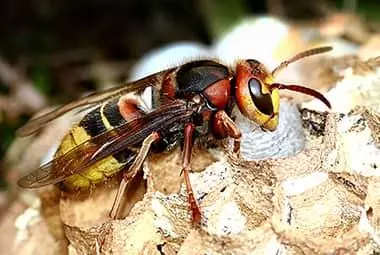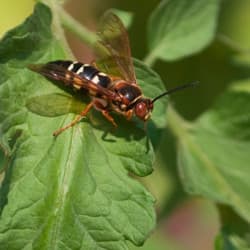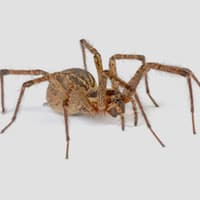Cicada Killer Wasps Sound Scary… Are They?
It can be disturbing to find a 2-inch wasp in your backyard. It is even more disturbing to find out that wasp has a scary name like cicada killer wasp; but these wasps aren’t nearly as dangerous as you might be led to believe–well, unless you happen to be a cicada. Then, they are dangerous. Very dangerous!
Cicada killer wasps get their name from the fact that they kill cicada bugs. Not only do they kill them, but they also go through great effort to drag the dead cicada bugs back to their homes to feed their young. The entire process is quite fascinating. Female cicada killer wasps dig long tunnels with multiple chambers for holding cicada bugs. When cicadas are brought back to the tunnels they are deposited into the chambers and embedded with the eggs. This is to give the baby wasps something to feed on after they hatch.
Sandboxes, sand traps on golf courses, and other sandy areas are prime nesting places for these insects. They can also be found in gardens, flower beds, lawns, and large grassy areas. When they invade residential yards, they become pests by creating unsightly mounds everywhere and scaring families with their startling size; but, as stinging insects go, the cicada killer wasp isn’t so bad.
Like carpenter bees, the males of this wasp species do not have the ability to sting. They can be quite aggressive if you get near their nesting area, but it is all posturing. They have no way to back up their threats.
The female can sting, but its sting is no worse than that of a paper wasp. These insects are usually considered nuisance pests because of the ability to cause fear, or lawn pests because of their ability to damage the root system of a lawn.
Cicada killer wasps don’t generally pay much attention to humans. The food source for adults is tree sap and the nectar of flowers. Their focus is only on collecting cicada to feed their young; there isn’t much time left in their day to sting you. However, that doesn’t necessarily mean you want to have them around.
If lawn damage and giant wasps buzzing around your home making cicadas sheik in agony as they die is something you can live without, we’d be happy to help you with that. At Russell’s Pest Control we know how to take care of cicada killer wasps and a whole host of other unwelcome pests.
Pests will invade, but you don’t have to live with them. Get protected and stay protect with Russell’s Pest Control.
All You Need To Know About Wolf Spiders
Perhaps the first word that comes to mind when discussing a wolf spider is that they are very intimidating. The wolf spider is quite large in comparison to other spiders, ranging upwards of an inch or more not counting the legs. The wolf spider will bite when feeling threatened; however, their venom is rather weak and not harmful to humans. The most you can expect to experience is usually no more than some redness and swelling, but nothing more serious than that has been reported.
The coloring of the wolf spider results in a rather camouflaged appearance of brown, grey, tan, and black with some darker markings. This helps them when hunting their prey as well as protecting them against predators. The wolf spider can be found in almost any corner of the world as long as there is a good supply of insects available for food.
Wolf spiders have incredible night vision and do most of their hunting in the dark. They do not spin webs for which to catch their prey but rather depend on their size and strength to overpower insects. The wolf spider burrows into the ground rather than nesting in a web. Even then, the female will carry her egg sac with her rather than leaving it unprotected.
Mating time is quite risky for the male as they are sometimes killed by the female after the mating has taken place. Those males who do survive will often mate again. The mated female will lay approximately 100 eggs which she will encase in a sac that she carries with her. When the eggs are developed and ready to hatch, the female wolf spider will rip the egg sac open and release her baby spiders. The spiderlings will then climb onto the female’s body and stay with her for a couple weeks until mature enough to be on their own.
With their reproductive ability, wolf spiders can populate a home rather quickly. Even though they have a tendency to burrow into the ground, they will come inside from time to time. Although their bite is not dangerous, it is recommended that professional help is called on for eradication. While there are prevention tips that will help prevent an invasion of wolf spiders, contacting Russell’s Pest Control is advisable for control of a wolf spider infestation. Our Power Programs, designed to prevent and protect, will protect you from wolf spiders plus 30 or more other household pests with guaranteed year round pest free protection.
Is Dropping The Ball A Good Thing?
We think it is safe to say that most Americans (and probably most people in the English-speaking world) have all seen the ball drop at Times Square on New Year’s Eve. Perhaps only on television, but they’ve seen it. But do you know how this time-honored tradition came to be? Well, it turns out that the actual notion of a ball dropping to signal the passage of time dates back long before New Year’s Eve in Times Square. The first “time-ball” was actually installed on top of England’s Royal Observatory at Greenwich in 1833. This ball would drop at 1:00 p.m. every day, allowing the captains of nearby ships to set their chronometers precisely. After this, around 150 public time-balls are believed to have been installed around the world.
In the case of New Year’s Eve in Times Square, it can be said that dropping the ball is a good thing. However, there are a lot of other times and places where dropping the ball is definitely not a good thing. Take controlling pests for example. If a homeowner does not keep up with pest management and their home becomes infested with pests, this “dropping the ball” is definitely bad.
There are many things that can be done in order to deter pests from coming into your home. The following is a do-it-yourself list of tips:
-
Keep your yard free of clutter. Bugs and rodents love clutter to hide in.
-
Trim trees and bushes back away from your home. Pests can use leaves and branches as bridges to climb onto your home.
-
Make sure all screens and door sweeps are in good working order.
-
Seal up any gaps or cracks in your foundation, walls or roof area using a caulking gun.
-
Remove any standing water from your yard.
-
Thoroughly clean your home, paying close attention to areas where food is prepared and served. Don’t forget hard-to-reach areas, such as under the refrigerator and between the stove and counter.
-
Store all food in the refrigerator, or in tightly sealed plastic containers.
-
Only put pet food down at meal times, and make sure pet food is also stored in sealed containers.
-
Don’t leave dirty dishes stacked by the sink. Either wash them right away or put them in a sink full of soapy water.
-
Make sure your drawers and cabinets are free of crumbs and other food particles.
If you are serious about keeping household pests out, or if you need to get rid of pests, you might want to consider contacting the professionals. In business since 1971, the folks here at Russell’s Pest Control have learned a few things. With pest packages starting at just $29/month, our locally owned and family operated pest control company is fully geared to help you get rid of household pests, and keep them out. If you don’t want to drop the ball regarding pest control, give Russell’s a call. We’ll make sure you have a pest-free* new year!
Happy New Year, from your friends here at Russell’s Pest Control!
Pest Control Risks In Christmas Decorations
It is that time of year again. Time to dig out the boxes of Christmas decorations from the back of the closet, attic, or basement. After being out of sight and out mind for an entire year there are often a lot of surprises- ornaments, decorations, and memories that you forgotten about. But, if you are not careful there could be other surprises in those boxes as well- insects, rodent nests and other creepy critters that have made your holiday decorations their home over the last year. Yikes!
Here at Russell’s Pest Control we don’t want you to have any unpleasant surprises. Here is some information and tips to help make sure that when you bring out your holiday decoration this year, you are only introducing glitter, shine and holiday joy into your home, and not pest and their debris and diseases.
Tips for the pest-free* unpacking of your Christmas decorations:
- After digging out the decorations and ornaments, if the weather permits, place the boxes outside to unpack. This way if any pests have made their way into those boxes over the winter, they will hopefully scurry away outside, instead of under your couch.
- Before digging into these boxes, inspect them. If you notice chew marks, feces, or other signs of pest activity, it is a very good indicator that you have a pest problem somewhere in your home and that action needs to be taken. Getting help will not only take care of your current infestation but will allow the steps to be taken to prevent future issues with pests.
- Inspect ornaments and decorations for signs of being chewed on, breakage, and other damages. Any ornaments, lights, or decorations that have been damaged by pests, age, or accidents should be thrown away because they can be a safety risk.
- After you unpacked your Christmas decorations from cardboard boxes, throw those boxes out! Go to the store and purchase plastic containers with tight fitting lids to store your decorations and ornaments back into. This small step will help a lot to prevent pests from getting into and ruining your decorations in the future.
- If you will be purchasing and placing real wreaths or Christmas trees into your home you should first inspect them for pest activity. Check trees or wreaths for insect activity and shake them out before bringing them into your home. Don’t give insects and pests an open door and ride into your home.
After unpacking your decorations this Christmas season, hanging your wreaths and trimming your tree, if you notice any possible signs of pest activity the pros here at Russell’s Pest Control are eagerly awaiting your call. Our experts can inspect your home, eliminate any infestation through our safe and effective treatments, and provide follow-up services through our home pest control services. We want to work with you to make sure that your home is pest free, your family is healthy and that your holidays are merry and bright!
Adult Fleas Are Only The Tip Of The Iceberg
Are fleas driving you and your pets crazy? Have you already washed all the bedding in the house and vacuumed all the rugs twice, but those fleas won’t go away? It can be a real pain to get rid of these blood-eating pests, especially if you don’t understand what you’re up against. The scary truth about fleas is that only 5 percent of the fleas in your home are adult fleas. Those are the ones you notice. Those are the ones that wiggle through your pet’s fur when you part it down the middle or spring onto you when you sit on the couch. But there is a vast population of fleas you don’t see.
Pupae Stage
The next highest population of fleas you’ll find in your home are fleas that have grown to the pupae stage. This is when they have matured enough to make their own cocoon. In this stage they will be hiding in your pet’s bedding, behind baseboards, under furniture, in your rugs, and in other out-of-the-way places. Cocooned pupae make up 10 percent of all the fleas typically found in an infested home.
Larvae Stage
These are the baby fleas, and they make up an alarming 35 percent of the flea population in your home. Why is this alarming? Because all those babies are going to eventually cocoon and turn into adult fleas that bite. In the Larvae stage, they don’t eat a blood meal. They eat pre-digested blood from adult fleas (called flea “dirt”). But someday, they will be crawling on your pet’s fur and crawling in your bed.
Eggs
Here is where it gets scary. Eggs make up 50 percent of the flea population in a home. These are laid in bunches of about 20 (usually in the fur of your pet) after a flea has had a blood meal. But, unlike many other insect eggs, flea eggs are not sticky. This allows them to roll off of your pet and “seed” the house.
What can we learn from all this?
If you’re trying to kill “adult” fleas, you will lose this battle. Adult fleas are only the tip of the iceberg. You need to kill the eggs, larvae, and pupae as well. This requires an application of special products to strategic areas inside your home.
If you’ve been battling fleas and you’re ready for the nightmare to be over, give Russell’s Pest Control a call. Our technicians know how to treat for fleas in a way that is safe for you, your children, and your pets. We don’t just kill adult fleas, we kill all stages of fleas in your home. If you were following the math, that is 100% of all the flea population in your home.





